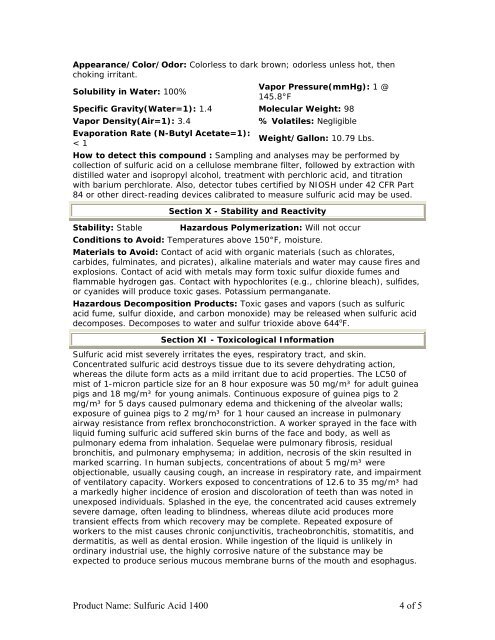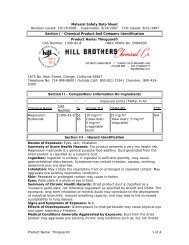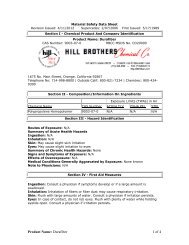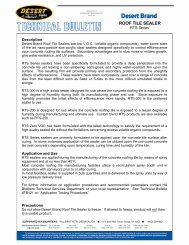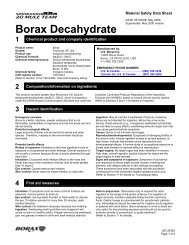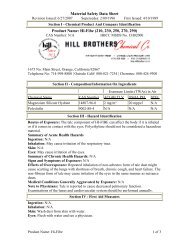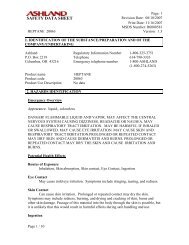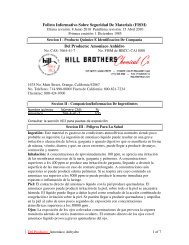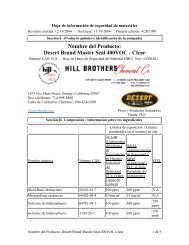sulfuric acid 1400 1 of 5 - Hill Brothers Chemical Co.
sulfuric acid 1400 1 of 5 - Hill Brothers Chemical Co.
sulfuric acid 1400 1 of 5 - Hill Brothers Chemical Co.
You also want an ePaper? Increase the reach of your titles
YUMPU automatically turns print PDFs into web optimized ePapers that Google loves.
Appearance/<strong>Co</strong>lor/Odor: <strong>Co</strong>lorless to dark brown; odorless unless hot, then<br />
choking irritant.<br />
Solubility in Water: 100%<br />
Vapor Pressure(mmHg): 1 @<br />
145.8°F<br />
Specific Gravity(Water=1): 1.4 Molecular Weight: 98<br />
Vapor Density(Air=1): 3.4<br />
Evaporation Rate (N-Butyl Acetate=1):<br />
< 1<br />
% Volatiles: Negligible<br />
Weight/Gallon: 10.79 Lbs.<br />
How to detect this compound : Sampling and analyses may be performed by<br />
collection <strong>of</strong> <strong>sulfuric</strong> <strong>acid</strong> on a cellulose membrane filter, followed by extraction with<br />
distilled water and isopropyl alcohol, treatment with perchloric <strong>acid</strong>, and titration<br />
with barium perchlorate. Also, detector tubes certified by NIOSH under 42 CFR Part<br />
84 or other direct-reading devices calibrated to measure <strong>sulfuric</strong> <strong>acid</strong> may be used.<br />
Section X - Stability and Reactivity<br />
Stability: Stable Hazardous Polymerization: Will not occur<br />
<strong>Co</strong>nditions to Avoid: Temperatures above 150°F, moisture.<br />
Materials to Avoid: <strong>Co</strong>ntact <strong>of</strong> <strong>acid</strong> with organic materials (such as chlorates,<br />
carbides, fulminates, and picrates), alkaline materials and water may cause fires and<br />
explosions. <strong>Co</strong>ntact <strong>of</strong> <strong>acid</strong> with metals may form toxic sulfur dioxide fumes and<br />
flammable hydrogen gas. <strong>Co</strong>ntact with hypochlorites (e.g., chlorine bleach), sulfides,<br />
or cyanides will produce toxic gases. Potassium permanganate.<br />
Hazardous Decomposition Products: Toxic gases and vapors (such as <strong>sulfuric</strong><br />
<strong>acid</strong> fume, sulfur dioxide, and carbon monoxide) may be released when <strong>sulfuric</strong> <strong>acid</strong><br />
decomposes. Decomposes to water and sulfur trioxide above 644 o F.<br />
Section XI - Toxicological Information<br />
Sulfuric <strong>acid</strong> mist severely irritates the eyes, respiratory tract, and skin.<br />
<strong>Co</strong>ncentrated <strong>sulfuric</strong> <strong>acid</strong> destroys tissue due to its severe dehydrating action,<br />
whereas the dilute form acts as a mild irritant due to <strong>acid</strong> properties. The LC50 <strong>of</strong><br />
mist <strong>of</strong> 1-micron particle size for an 8 hour exposure was 50 mg/m³ for adult guinea<br />
pigs and 18 mg/m³ for young animals. <strong>Co</strong>ntinuous exposure <strong>of</strong> guinea pigs to 2<br />
mg/m³ for 5 days caused pulmonary edema and thickening <strong>of</strong> the alveolar walls;<br />
exposure <strong>of</strong> guinea pigs to 2 mg/m³ for 1 hour caused an increase in pulmonary<br />
airway resistance from reflex bronchoconstriction. A worker sprayed in the face with<br />
liquid fuming <strong>sulfuric</strong> <strong>acid</strong> suffered skin burns <strong>of</strong> the face and body, as well as<br />
pulmonary edema from inhalation. Sequelae were pulmonary fibrosis, residual<br />
bronchitis, and pulmonary emphysema; in addition, necrosis <strong>of</strong> the skin resulted in<br />
marked scarring. In human subjects, concentrations <strong>of</strong> about 5 mg/m³ were<br />
objectionable, usually causing cough, an increase in respiratory rate, and impairment<br />
<strong>of</strong> ventilatory capacity. Workers exposed to concentrations <strong>of</strong> 12.6 to 35 mg/m³ had<br />
a markedly higher incidence <strong>of</strong> erosion and discoloration <strong>of</strong> teeth than was noted in<br />
unexposed individuals. Splashed in the eye, the concentrated <strong>acid</strong> causes extremely<br />
severe damage, <strong>of</strong>ten leading to blindness, whereas dilute <strong>acid</strong> produces more<br />
transient effects from which recovery may be complete. Repeated exposure <strong>of</strong><br />
workers to the mist causes chronic conjunctivitis, tracheobronchitis, stomatitis, and<br />
dermatitis, as well as dental erosion. While ingestion <strong>of</strong> the liquid is unlikely in<br />
ordinary industrial use, the highly corrosive nature <strong>of</strong> the substance may be<br />
expected to produce serious mucous membrane burns <strong>of</strong> the mouth and esophagus.<br />
Product Name: Sulfuric Acid <strong>1400</strong> 4 <strong>of</strong> 5


